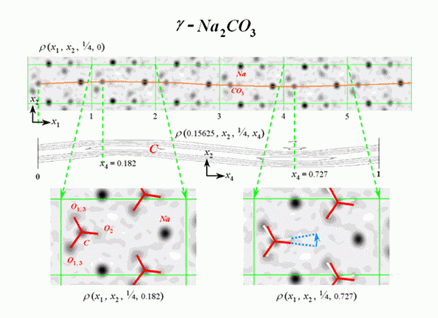
Multi-dimensional Direct Methods

References:
[1] Fan, Hai-fu, "DIMS on the VEC platform" CompComm Newsletter
No.5, pp. 16-23 (2005)


[2] Fan, Hai-fu, "DIMS/VEC applications" CompComm Newsletter
No.5, pp. 24-27 (2005)


Background![]() Approach
Approach
![]() Results
Results
![]() Publications
Publications
In
diffraction analysis, crystal structures are usually assumed to be ideal
3-dimensional periodic objects. Since real crystals are never perfect,
what we obtained is just an averaged image of the real structure over a
large number of unit cells. However a knowledge on the average structure
is not enough for understanding the properties of many solid state materials.
Therefore an important task for methods of solving crystal structures is
to extend their scope to include real crystals. Modulated crystal structures
belong to that kind of crystal structures, in which atoms suffer from certain
substitutional and/or positional fluctuation. If the period of fluctuation
matches that of the three-dimensional unit cell then a superstructure results,
otherwise an incommensurate modulated structure is obtained. Incommensurate
modulated phases can be found in many important solid state materials.
In many cases, the transition to the incommensurate modulated structure
corresponds to a change of certain physical properties. Hence it is important
to know the structure of incommensurate modulated phases in order to understand
the mechanism of the transition and properties in the modulated state.
Many incommensurate modulated structures were solved by trial-and-error
methods. With these methods it is necessary to make assumption on the modulation
in advance. This leads often to difficulties and erroneous results. In
view of diffraction analysis, it is possible to phase the reflections directly
and solve the structure objectively without relying on any assumption about
the modulation wave.
A
common feature of incommensurate modulated structures is that they do not
have 3-dimensional periodicity. However incommensurate modulated structures
can be regarded as the 3-dimensional hypersection of a 4- or higher-dimensional
periodic structure. Obviously direct analysis of incommensurate modulated
structures would better be implemented in multi-dimensional space. For
this purpose we need firstly a theory on multi-dimensional symmetry and
secondly a method to solve directly the multi-dimensional phase problem.
The work of Janner and co-workers (see Janssen, T., Janner, A., Looijenga-Vos,
A. and De Wolff, P. M. (1992), in Wilson, A. J. C. Ed. International
Tables for Crystallography, Vol. C, Kluwer Academic Publishers, Dordrecht,
pp. 797-835; 843-844.) has treated the first problem, while the multidimensional
direct methods developed in our group are aiming at the second.